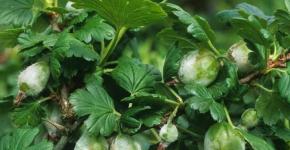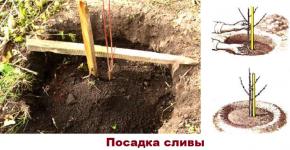Canadian Spruce Konik: Features of Planting and Care
Spruce "Konika" or "Canadian spruce" according to the botanical description, belongs to the species of the genus of the Pine family. This ornamental evergreen plant reaches a height of 0.5 meters in flowerbeds and terraces, and 2 meters in the garden. The homeland of this beautiful plant is considered to be North America, where it was first used for decorative purposes in the early twentieth century. In this article, we will talk about how to properly plant a Canadian spruce and care for it.
The landing site must be maximum wind protection. Due to the peculiarities of the root system, the Konik spruce can die if it is planted in a place with a strong wind. This tree has one feature: over time, the taproot dies off, and the plant is held in the soil only by superficial roots. Winds are especially dangerous for old plants, whose age has exceeded 12-15 years.
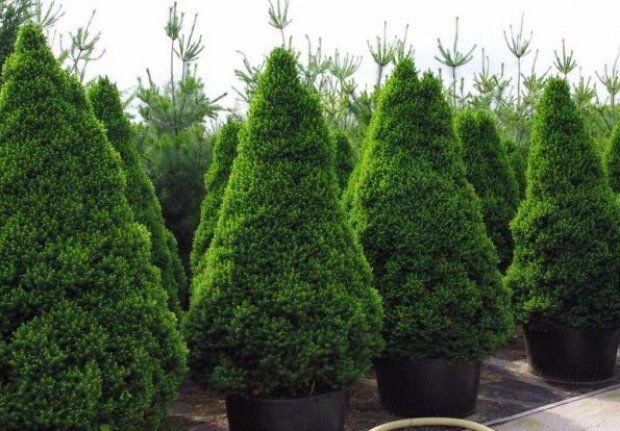
Also consider the fact that this loves a lot of sunlight. Partial shade may also be suitable for planting. But if you plant a plant in the shade, then it can lose all its decorative effect. In addition, the tree will grow more slowly, and over time it may completely wither and die.
Best time to land
This type of ornamental plant can be planted in open soil. almost any time of the year. In the southern regions of our country, a tree can be planted even in winter, when it is at rest. But the best time for planting will be the middle - the end of spring, or the beginning - the middle of autumn.
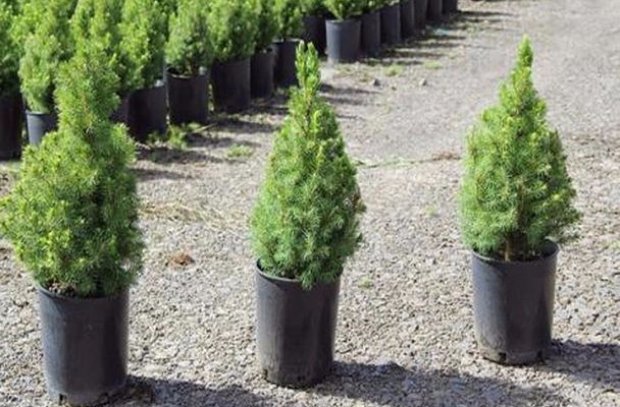
There is a lot of controversy and discussion about how to plant a Konik spruce in the summer, and whether it is worth doing it at all on hot days. In most cases, experts do not advise doing this in the middle of summer, but if you do decide to plant a tree in the summer, it is best to do it in cloudy and cool weather. And after planting, the plant needs to be twice a week (8-10 liters of warm water should be poured onto one tree).
planting material requirements
When buying a Christmas tree pay attention to the color of the needles, which should be intense. If you buy a seedling in a nursery that has grown in a container, then turn the container over: if the earth does not spill out of it, then the planting material is good. The roots of the purchased seedling should be wrapped in a damp cloth or net.
Did you know? ATThe first botanical description of the Canadian spruce was made by the English scientist Philip Miller (1691 - 1771).In the Botanical Garden of the BIN RAS, one of the oldest in Russia, Canadian spruce was listed in catalogs in 1816.
A seedling is inserted into the prepared hole along with a clod of earth. The root neck (the junction of the root and trunk) should remain at ground level and in no case go deeper. Then planting material should be sprinkled with fertile soil and compacted a little. After pour warm water and, if necessary, secure (can be tied to two pegs).
Important! It is not recommended to purchase spruce seedlings with bare roots. Such planting material will hurt a lot, and in the worst case, it may even die.
After the spruce is planted and fixed, the soil around it can be slightly sprinkled with humus. In this case, the seedling will quickly start growing and take root.
How to care
Canadian spruce Konik after planting in open ground requires special care. Timely watering, loosening and top dressing are the key to the decorativeness of your tree.
Watering and loosening the soil
Mature and established spruce normally tolerate two to three weeks of summer drought. But young dwarf trees need watering at least once every 1.5 weeks.
Did you know?Spruce wood was used in the manufacture of violins by such string instrument makers as Amati and Stradivari. Musical instruments made from such wood sound very beautiful due to the even distribution of the fibers.
It is necessary to loosen the soil during dry periods, which often occur only in summer. Loosening contributes to the fact that the internal soil moisture will evaporate less. At the same time, irrigation and rainwater will be better absorbed into such soil.
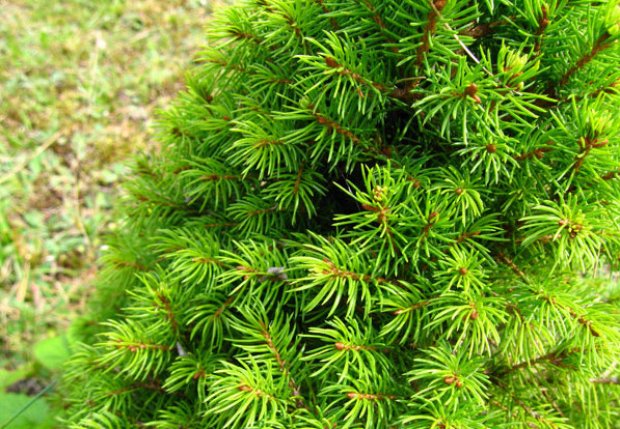
Top dressing and mulching
With a strong excess of moisture, the upper roots of spruce can rot. To prevent this from happening, the soil around the tree needs either shavings of coniferous trees, needles or bark.
Mulch helps to balance soil moisture and maintain its normal characteristics. Sometimes the soil around the plant is covered with decorative stones, such as expanded clay. This method of mulching, among other things, adds beauty to any terrace or alley.
Diseases and pests
Spruce Konik can be exposed to some and damaged by various. Timely struggle will help your plant stay beautiful and healthy. Here list of major diseases and pests of Canadian spruce:
- Coniferous disease Schutte. The disease is fungal in nature. The plant first acquires a black tint, then it becomes covered with "hoarfrost", and then all the needles begin to fall off. With the timely detection of an ailment, the plant can be sprayed with a 3% solution of copper sulfate, or. With a severely neglected disease, the tree must be cut.
- Tracheomycosis is a fungal disease of the root system of coniferous trees. This disease in most cases affects young trees. The needles redden over time and fall off. This disease is not treatable. Affected plants are cut and burned, and the soil is treated with a solution of copper sulfate.
- - another type of fungal disease that affects the needles and forms yellow or orange growths on it. Over time, the needles begin to fall off. This disease is treated or "Vectra". Processing should be done once a week for a month.
- Sometimes the bark of an ornamental plant is affected by small brown or black bugs, which are called. They gnaw through the bark, lay their eggs there, and feed on wood. The chance to save the plant in this case is reduced to almost zero.
- Spruce needles can be affected by a spruce larva, which is capable of laying up to 1500 eggs. She feeds on needles, as a result of which the latter falls off. To combat this insect, a 0.3% solution is used.
Any ailment contributes to the suppression of the decorative effect of spruce. Proper and timely care of the plant will not allow fungi to hit it.
Shelter for the winter
Coniferous trees with particular ease endure even the most severe winter frosts. Only young and recently planted spruces, whose root system has not yet fully established itself in the soil, can suffer. Such plants need wrap with net or twine. This is done carefully so as not to break off the branches.
Important!If for the winter spruce with lutrasil, then its thickness should be at least 60 microns. Otherwise, there is a risk of frostbite of the needles. Old Canadian spruces that have been decorating your garden, terrace or alley for more than one year do not need to be covered. It is enough to water them well in late autumn, and they will calmly overwinter severe frosts.
Use in landscape design
Spruce Canadian Konika is one of the most popular types of conifers that are used in. It looks good both in a single performance and in a group. When a young seedling reaches its optimum height, it becomes an excellent decoration.
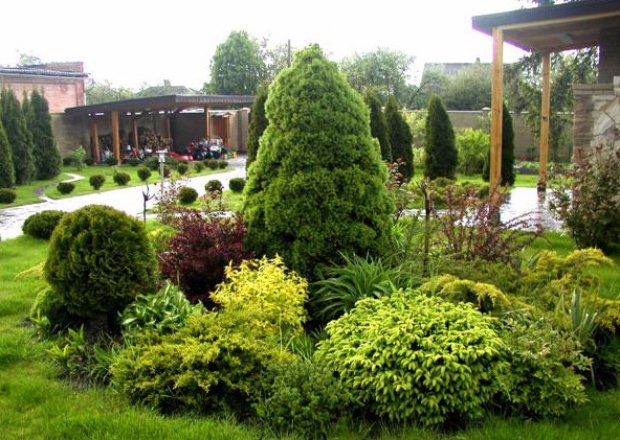
Canadian spruce can often be found in containers on terraces, balconies, rooftops, alleys, etc. It will be an excellent decoration for the background of any rock gardens. In addition, the Konik spruce harmoniously looks on a flat and low lawn, among others.
In any case, this tree will be an excellent decoration for each individual balcony or. Spruce Konika harmonizes perfectly with absolutely any or plants. If the Canadian spruce is properly cared for, then it will give you its beauty for decades.
Was this article helpful?
Not really

